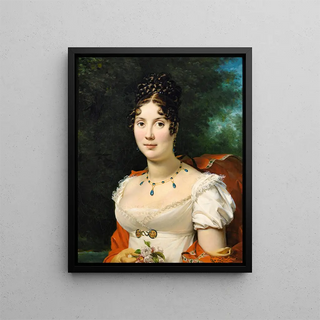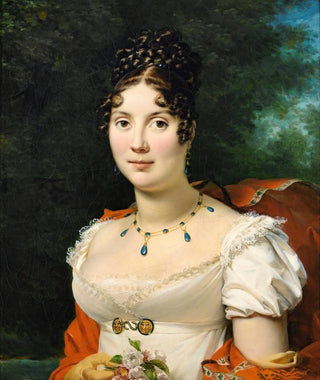Painting Portrait of a Young Woman - François Gérard | Art print


View from behind

Frame (optional)
Portrait of a Young Woman - François Gérard – Captivating Introduction
The "Portrait of a Young Woman" by François Gérard is a masterpiece that transcends time and eras, capturing the very essence of female beauty in the early 19th century. This painting, imbued with delicacy and subtlety, transports us into a universe where every detail is carefully considered. The young woman, whose gaze appears both dreamy and determined, embodies timeless elegance, inviting the viewer to delve into her thoughts. Gérard, a master of portraiture, manages to create a palpable connection between the subject and the observer, making this work fascinating and captivating.
Style and uniqueness of the artwork
François Gérard's style is distinguished by its refined approach and masterful use of light and shadow. In this portrait, soft colors and delicate nuances blend harmoniously, creating an atmosphere that is both intimate and dreamlike. The young woman, dressed in a light gown, is surrounded by a blurred background that emphasizes her presence and highlights her fine features. Details such as the texture of the fabrics and the luminosity of her skin demonstrate striking realism, while maintaining a certain idealization characteristic of Romantic art. Gérard succeeds in capturing not only the appearance of his model but also an emotion, a story, making this work a true masterpiece.
The artist and his influence
François Gérard, born in 1770, is one of the most renowned portraitists of his time, having established himself in the Parisian artistic scene. His work is marked by a transition between Neoclassicism and Romanticism, allowing him to play with conventions while remaining faithful to his era. Gérard had the honor of painting many prominent figures of his time, from members of the court to literary personalities, which attests to his influence and recognition. His ability to capture the soul of his subjects made him a model for many artists who followed. Through his portraits, he contributed to shaping the image of women in art, presenting them not only as objects of beauty but also as complex beings endowed with thoughts.

Matte finish

View from behind

Frame (optional)
Portrait of a Young Woman - François Gérard – Captivating Introduction
The "Portrait of a Young Woman" by François Gérard is a masterpiece that transcends time and eras, capturing the very essence of female beauty in the early 19th century. This painting, imbued with delicacy and subtlety, transports us into a universe where every detail is carefully considered. The young woman, whose gaze appears both dreamy and determined, embodies timeless elegance, inviting the viewer to delve into her thoughts. Gérard, a master of portraiture, manages to create a palpable connection between the subject and the observer, making this work fascinating and captivating.
Style and uniqueness of the artwork
François Gérard's style is distinguished by its refined approach and masterful use of light and shadow. In this portrait, soft colors and delicate nuances blend harmoniously, creating an atmosphere that is both intimate and dreamlike. The young woman, dressed in a light gown, is surrounded by a blurred background that emphasizes her presence and highlights her fine features. Details such as the texture of the fabrics and the luminosity of her skin demonstrate striking realism, while maintaining a certain idealization characteristic of Romantic art. Gérard succeeds in capturing not only the appearance of his model but also an emotion, a story, making this work a true masterpiece.
The artist and his influence
François Gérard, born in 1770, is one of the most renowned portraitists of his time, having established himself in the Parisian artistic scene. His work is marked by a transition between Neoclassicism and Romanticism, allowing him to play with conventions while remaining faithful to his era. Gérard had the honor of painting many prominent figures of his time, from members of the court to literary personalities, which attests to his influence and recognition. His ability to capture the soul of his subjects made him a model for many artists who followed. Through his portraits, he contributed to shaping the image of women in art, presenting them not only as objects of beauty but also as complex beings endowed with thoughts.
12,34 €






